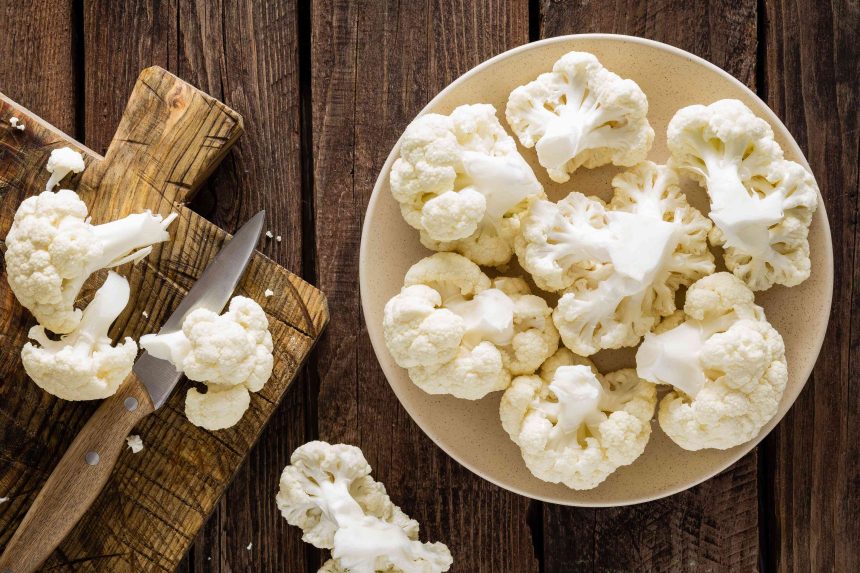Cauliflower tends to get less love than its more popular relative, broccoli. Perhaps people aren’t sure what to do with the typically colorless crop or have had one too many bland preparations. But with several chefs chiming in with the best way to cook cauliflower—including Top Chef Season 21 winner Danny Garcia—things are looking up for the cruciferous vegetable. While there are many ways to prepare the versatile vegetable, the chefs we spoke with all agreed that one method was the best. Spoiler alert: it’s frying. Read on to learn more about cauliflower and why they love this method, plus other ways to prepare the vegetable.
Types of Cauliflower
White cauliflower is the most common type found in supermarkets. And it’s white because growers shade the heads, or “curds,” from sunlight, inhibiting chlorophyll, the color-producing pigment that makes plants green. Several other varieties also exist—each with a unique color and flavor profile. Here are a few to explore.
- Romanesco. This green-hued cauliflower-broccoli hybrid boasts a striking fractal pattern that has earned it the moniker “dinosaur broccoli.” It has a nuttier flavor than white cauliflower and a creamy interior texture.
- Purple. Purple cauliflower—including Violet Queen, Sicilian Violet and Purple Cape—gets its purple tint from anthocyanins, a group of antioxidants found in many purple, blue and red fruits and vegetables, including grapes and red cabbage. It has a mild, slightly sweet flavor that is most prominent when eaten raw.
- Orange. This vibrant variety is sometimes called “Cheddar” cauliflower because of its color that ranges in intensity from a soft yellowish hue to an intense, bright orange. The color is naturally developed by the high levels of beta carotene stored in the florets that also give this variety an extra dose of vitamin A. Like purple cauliflower, it’s mild with a hint of sweetness.
Popular Ways to Prepare Cauliflower
Cauliflower readily absorbs flavors, making it a versatile ingredient that can be transformed in a number of ways. The most popular method might be steaming—a plain but pleasant way to enjoy cauliflower when topped with butter or olive oil and fresh herbs—but there are several other common preparations, such as the following.
- Roasting. This method involves cooking cut cauliflower florets with dry heat at oven temperatures typically ranging from 400°F to 450°F. This high heat allows the flavors to develop by caramelizing the natural sugars. It also results in a crispy texture. A drizzle of oil helps preserve moisture, while a sprinkle of salt further intensifies the flavors.
- Sautéing. Sautéing cauliflower is another dry-heat cooking method. It involves frequently tossing or stirring the cauliflower in a hot pan with a small amount of oil, or another cooking fat, until the surfaces are browned and a tender texture is achieved. Because coarsely chopped cauliflower heads can take a while to cook through, many recipes suggest par-steaming them before sautéing.
- Grilling. Cauliflower steaks have become an increasingly popular cooking method, especially within plant-based diets. The head is cut into about 1-inch-thick vertical slices, then drizzled with oil and seasoned before being placed on a hot grill for 2 to 3 minutes per side. The result is a soft, meaty texture and smoky flavor complete with grill marks.
Chefs’ Preferred Way to Cook Cauliflower
While the chefs we interviewed are undoubtedly skilled at cooking cauliflower in more ways than one, their favorite method is surprisingly none of the above: it’s frying.
“I love to shallow-fry cauliflower florets in olive oil, then finish by roasting them in the oven. This ensures that every nook and cranny of the cauliflower is coated in oil to prevent dryness but still provides the crispy bits you’d expect from roasted cauliflower. I like to serve it with vadouvan, raisins, pickled onions, labneh and a bunch of fresh herbs,” says Danny Garcia, executive chef at Time and Tide and Top Chef Season 21 winner. To achieve these results at home, Chef Danny says to cut the head into larger pieces for optimal texture and to make sure to coat them in enough oil to avoid any dry spots. He finishes the fried florets with a generous sprinkling of salt.
To intensify the texture in his favorite crispy glazed cauliflower, Richard LaMarita, chef-instructor of Plant-Based Culinary Arts at the Institute of Culinary Education, says to cut the cauliflower into bite-size pieces, then fully immerse them in oil heated to 350°F for about a minute or until they have a crispy texture and golden color. “Crispy spiced cauliflower is a big thing right now. One of my favorite [glazes] is chili-tamarind. I like to combine celery root with cauliflower for a pleasant surprise in this dish,” he says, adding, “While it is hot, toss it in the [glaze]. It can be roasted briefly again to warm it and get the sauce to bake on if you’re not serving it right away.”
Heather Golden Ray and Jenny Engel, sisters and owners of Hey, Sunshine Kitchen, turn to fried cauliflower when entertaining guests, calling it crunchy, tart and sweet. “We use a non-GMO rice bran oil because it’s a neutral-tasting, high-heat oil that leaves the cauliflower crunchy but not greasy,” says Heather. “We fry the cauliflower for 90 seconds to 2 minutes, depending on how thick it’s cut, then transfer it to a paper towel–lined baking sheet. We then transfer it to a large bowl and toss it in a vinaigrette, almonds and cranberries and top it with fresh mint.”
To mimic the fried texture, Brooke Williamson, chef and winner of Top Chef Season 14 and Tournament of Champions, roasts her cauliflower at a high 425°F. “The cauliflower is marinated in a very fragrant spiced marinade, including very sour yogurt and spices that include curry, turmeric and coriander,” says Chef Brooke, “The cauliflower is laid out in a single layer, being careful not to layer them on top of each other, so they don’t steam. Then they are roasted until the natural sugars are expelled and the beautiful golden roast is prevalent—a flavorful alternative to being fried.”
The Bottom Line
For cauliflower that’s anything but boring, fry it until crispy and golden, then toss it in a glaze or serve it with a creamy side to bring out the flavors and textures. To get similar results, minus the oil, try roasting it in a very hot oven.







